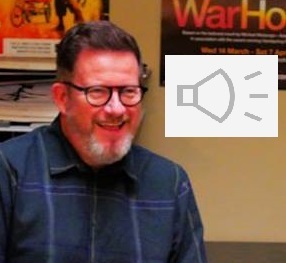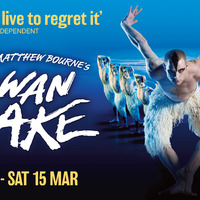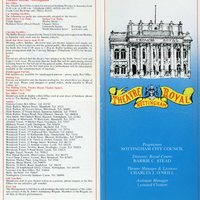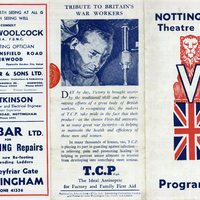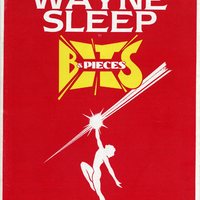Title
Matthew Bourne Interview: The Evolution of Swan Lake
Date
14 November 2018
Description
Oral history interview with Matthew Bourne of New Adventures, a unique dance-theatre company, a regular visitor to the Theatre Royal.
What's the story?
Sir Matthew Christopher Bourne OBE was born in Hackney, London in 1960. He started training as a dancer at the age of 22. He later went on to become sole artistic director of Adventures in Motion Pictures (AMP) and subsequently his latest company New Adventures in 2002.
Glenn Graham was born in Nottingham in 1980 and was educated at Top Valley Comprehensive School and Clarendon College. He was professionally trained at the Rambert School of Ballet & Contemporary Dance before joining New Adventures in 2003.
In this interview Matthew talks about the initial significance of Swan Lake and how it has evolved over time.
“Swan Lake is obviously very important to me because it changed my life and the life of the Company and made us an international company and put us on the map in a way that we’d never dreamt of. We’d never expected that to happen. It was way beyond our imagination really of what you could do in dance. So it’s a wonderful piece that brings us new audiences and brings us new friends around the world and has done historically. So that one’s very important. You know what to expect, I suppose. You’re taking on this thing which is so like the Holy Grail of ballet and people have an expectation of what it should be and probably most people who would come and see Swan Lake have probably already seen it before and are already ballet fans, so they’re going to get something a bit different. So it’s a very different sort of audience.
We had people walking out when we first did it, usually men when the Prince and the Swan started dancing together. A few men would get up and walk out. We had little girls in tears, who weren’t seeing ballerinas in tutus. And things like that. Angry mothers. These were so exceptional cases. Generally the audience was swept away and loved it. I have to say that. There was a lot of press and talk about it being shocking and all those things. It wasn’t really. What some of the press said, it was just a nice story to say that this thing was breaking boundaries, which it sort of did, but it wasn’t putting people off, I didn’t feel. But having said that, we did get that reaction and now there’s no question about bringing the children, bringing the family. I would say that you’re not going to bring very small children to Swan Lake, just because it’s very long as well, but now we play for eight weeks at Christmas at Sadlers Wells. It’s a bring the family Christmas show, which started out as something quite controversial.
That’s how things have changed over the last 23 years since we first did it. I would cringe if I saw the original one now. I didn’t know what the reaction was going to be to it. You then do react to how people react. I suppose it’s naturally developed because the Company’s developed. There are all sorts of reasons why I would cringe now a little bit to see the original because the standard of dancing, for example, that we have now is much higher. The people who audition for it are much … we get many more choices. We really struggled … I’m not going to run the original cast down because they were amazing, the 1995 cast, but we just about managed to find 14 male swans. It was a struggle to find good enough people who weren’t already in a company. There weren’t as many male dancers around at that time really who were available and they were all very different, as they still are, actually, all coming from different backgrounds. There were different considerations then with it. But it’s changed a lot. The design for this particular production we’re doing now in 2018 is new design and some new costumes and some new choreography and brand new lighting design that we’ve never had before, so a different look on the whole thing. A little bit of projection which we’ve never had before. In a subtle way, hopefully. So it has to keep evolving.”
Glenn Graham was born in Nottingham in 1980 and was educated at Top Valley Comprehensive School and Clarendon College. He was professionally trained at the Rambert School of Ballet & Contemporary Dance before joining New Adventures in 2003.
In this interview Matthew talks about the initial significance of Swan Lake and how it has evolved over time.
“Swan Lake is obviously very important to me because it changed my life and the life of the Company and made us an international company and put us on the map in a way that we’d never dreamt of. We’d never expected that to happen. It was way beyond our imagination really of what you could do in dance. So it’s a wonderful piece that brings us new audiences and brings us new friends around the world and has done historically. So that one’s very important. You know what to expect, I suppose. You’re taking on this thing which is so like the Holy Grail of ballet and people have an expectation of what it should be and probably most people who would come and see Swan Lake have probably already seen it before and are already ballet fans, so they’re going to get something a bit different. So it’s a very different sort of audience.
We had people walking out when we first did it, usually men when the Prince and the Swan started dancing together. A few men would get up and walk out. We had little girls in tears, who weren’t seeing ballerinas in tutus. And things like that. Angry mothers. These were so exceptional cases. Generally the audience was swept away and loved it. I have to say that. There was a lot of press and talk about it being shocking and all those things. It wasn’t really. What some of the press said, it was just a nice story to say that this thing was breaking boundaries, which it sort of did, but it wasn’t putting people off, I didn’t feel. But having said that, we did get that reaction and now there’s no question about bringing the children, bringing the family. I would say that you’re not going to bring very small children to Swan Lake, just because it’s very long as well, but now we play for eight weeks at Christmas at Sadlers Wells. It’s a bring the family Christmas show, which started out as something quite controversial.
That’s how things have changed over the last 23 years since we first did it. I would cringe if I saw the original one now. I didn’t know what the reaction was going to be to it. You then do react to how people react. I suppose it’s naturally developed because the Company’s developed. There are all sorts of reasons why I would cringe now a little bit to see the original because the standard of dancing, for example, that we have now is much higher. The people who audition for it are much … we get many more choices. We really struggled … I’m not going to run the original cast down because they were amazing, the 1995 cast, but we just about managed to find 14 male swans. It was a struggle to find good enough people who weren’t already in a company. There weren’t as many male dancers around at that time really who were available and they were all very different, as they still are, actually, all coming from different backgrounds. There were different considerations then with it. But it’s changed a lot. The design for this particular production we’re doing now in 2018 is new design and some new costumes and some new choreography and brand new lighting design that we’ve never had before, so a different look on the whole thing. A little bit of projection which we’ve never had before. In a subtle way, hopefully. So it has to keep evolving.”
Type
Oral interview
Location of item
Theatre Royal and Royal Concert Hall Nottingham
Rights
Theatre Royal and Royal Concert Hall Nottingham
Contributor
Interviewers: Jennifer Sherwood and Diane Jones
Transcriber: David Chilton
Transcriber: David Chilton
